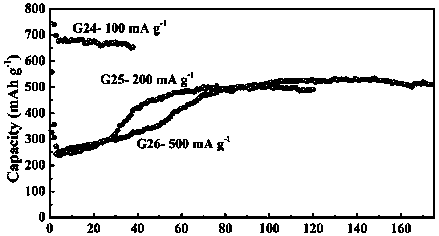Method for preparing lithium battery silicon carbide negative electrode composite material
A composite material, lithium battery technology, applied in battery electrodes, lithium storage batteries, carbon compounds, etc., can solve the problems of rapid capacity decay, limited development of silicon materials, poor conductivity, etc., to improve electrochemical stability and improve silicon volume effect. , the process is simple and controllable effect
- Summary
- Abstract
- Description
- Claims
- Application Information
AI Technical Summary
Problems solved by technology
Method used
Image
Examples
Embodiment 1
[0025] Ultrasonic cleaning of corner silicon waste in deionized water for 10 minutes to clean the dirt on the surface, and then drying to obtain silicon wafers; the obtained silicon wafers were pulverized for 25 minutes to make them pulverize to a median particle size of about 2 microns silicon powder; the obtained silicon powder and carbon nanotubes are mixed in ethanol at a mass ratio of 1:4, and the solid content is controlled to be 30%, and the resulting mixed solution is stirred at a speed of 800 rpm for 5 hours to obtain a uniform turbid liquid, and the stirred The solution was transferred to the reactor, calcined and kept at 600°C for 15 hours under nitrogen gas, and the heating rate was 5°C / min, and the calcined sample was ground by a ball mill to obtain the final silicon-carbon negative electrode composite material.
[0026] The prepared silicon-carbon composite material is made into a button battery, and the formula of the pole piece is mixed according to the mass rat...
Embodiment 2
[0029] Ultrasonic cleaning of corner silicon waste in deionized water for 15 minutes to clean the dirt on the surface, and then drying to obtain silicon wafers; the obtained silicon wafers were pulverized for 20 minutes to make them pulverize to a median particle size of about 3 microns silicon powder; the obtained silicon powder and graphite are mixed in benzene at a mass ratio of 1:6, and the solid content is controlled to be 35%, and the resulting mixed solution is stirred at a speed of 900 rpm for 10 hours to obtain a uniform turbid liquid, and the stirred solution is transferred to Into the reactor, calcination and heat preservation at 800°C with nitrogen gas for 20h, the heating rate is 5°C / min, and the calcined sample is ground by a ball mill to obtain the final silicon-carbon composite material.
Embodiment 3
[0031] Ultrasonic cleaning of corner silicon waste in deionized water for 6 minutes to clean the dirt on the surface, and then drying to obtain silicon wafers; the obtained silicon wafers were pulverized for 30 minutes until the median particle size was about 2 microns silicon powder; the obtained silicon powder and carbon nanotubes are mixed in acetone at a mass ratio of 1:8, and the solid content is controlled to be 40%, and the resulting mixed solution is stirred at a speed of 1000rpm for 20 h to obtain a uniform turbid liquid, which is stirred The solution was transferred to the reactor, calcined and kept at 700°C for 25 hours under nitrogen gas, and the heating rate was 5°C / min, and the calcined sample was ground by a ball mill to obtain the final silicon-carbon composite material.
PUM
 Login to View More
Login to View More Abstract
Description
Claims
Application Information
 Login to View More
Login to View More - R&D
- Intellectual Property
- Life Sciences
- Materials
- Tech Scout
- Unparalleled Data Quality
- Higher Quality Content
- 60% Fewer Hallucinations
Browse by: Latest US Patents, China's latest patents, Technical Efficacy Thesaurus, Application Domain, Technology Topic, Popular Technical Reports.
© 2025 PatSnap. All rights reserved.Legal|Privacy policy|Modern Slavery Act Transparency Statement|Sitemap|About US| Contact US: help@patsnap.com

